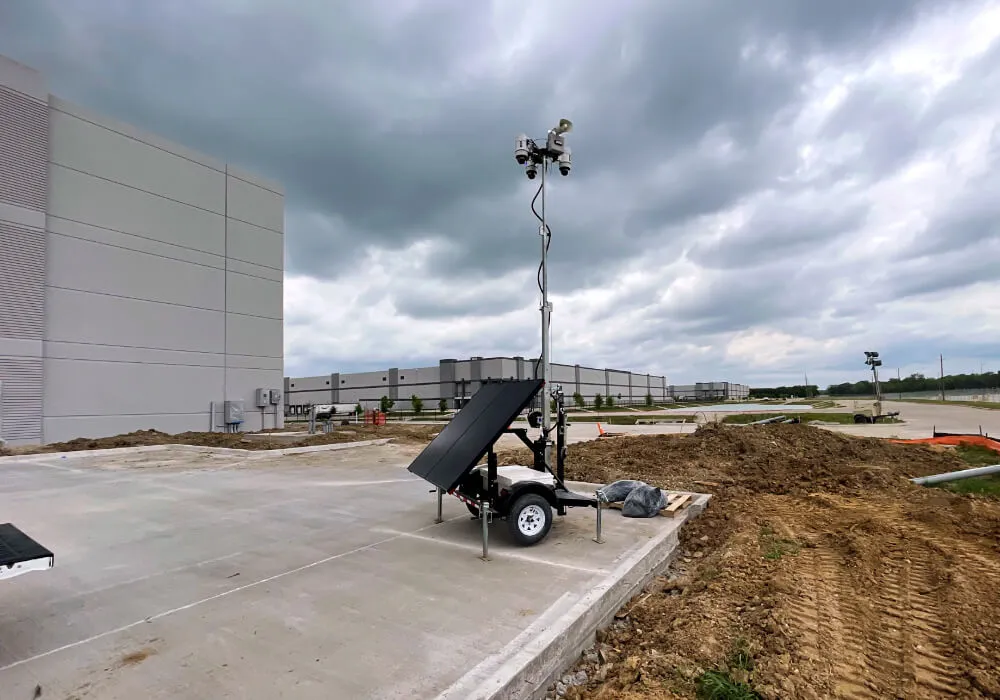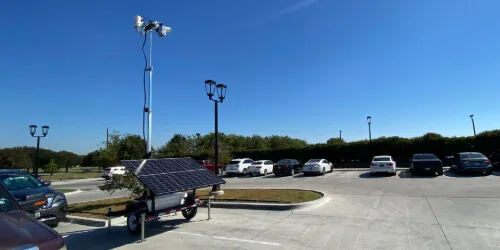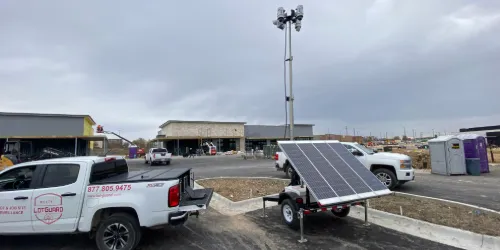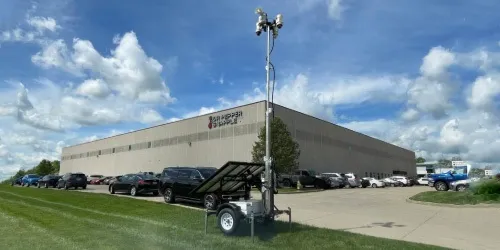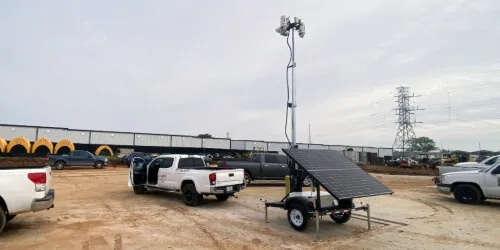In this post, we explore the different ways mobile solar surveillance trailers deliver cost savings to a range of security-conscious industries.
What are the Cost Benefits of Deploying Solar Surveillance Trailers?
There's an old saying that, in life, you get what you pay for. This mantra is usually repeated by folks trying to justify the high price tags that typically accompany premium products.
In many cases, though, there is strong logic behind this assertion. For example, spending a little extra on a decent-quality mattress is always worth it. There are few things more precious than a decent night's sleep (especially if, like me, you have a four-year-old son who is ready to wake you up before 5 a.m. every morning!).
Similarly, there's a reason why healthier, fresher food options cost more than processed, additive-laced, cheaper options. Want to live a healthier, longer life? Then a few bucks more is a fair trade-off.
However, occasionally, a solution comes along that is both ultra-high quality and budget-efficient. One example is mobile solar surveillance trailers.
These mobile surveillance units offer a host of benefits, from their positive environmental impact to their convenience of operation and robust security profile.
Another reason solar surveillance trailers are quickly becoming the go-to security solution for a range of industries is the cost benefits they deliver.
Below, we outline how solar surveillance trailers can help organizations save money and reduce operating costs while improving their overall security posture.
Minimal Installation Costs
Solar surveillance trailers are designed for rapid deployment at locations with zero-supporting infrastructure. They operate entirely autonomously without requiring connection to a fixed power supply or internet connectivity.
This makes them the ultimate drop-and-go security system, perfect for when urgent or temporary surveillance requirements emerge.
But their rapid deployment capability and autonomous operation also mean they deliver significant cost savings compared to traditional security cameras.
Set up time comparison:
- Traditional Security Cameras: Installing just one fixed security camera is time-consuming and labor-intensive, and often requires specialized skills and equipment. Multiply this across an entire city, construction jobsite, or parking lot, and costs quickly ramp up.
- Solar Surveillance Trailers: Solar trailers can be installed and fully operational in under 30 minutes, with just one person required for set up. There's no need for specialist skills, helping to minimize labor costs, and no construction work or cabling is required.
This simplified installation process reduces labor costs and the waiting time for surveillance units to become operational. Below, we outline how this can translate into real-world cost savings.
Example Cost Saving Calculation:
- Installation Costs: Traditional security cameras may take up to eight hours to install at a cost of $75 per hour per technician, totaling $600. A solar surveillance trailer setup would take less than one hour, costing a maximum of $75, saving $525 per installation. This assumes that a technician is deployed for installation; in most cases, trailers can be deployed by individuals with no previous training or expertise, removing installation costs entirely.
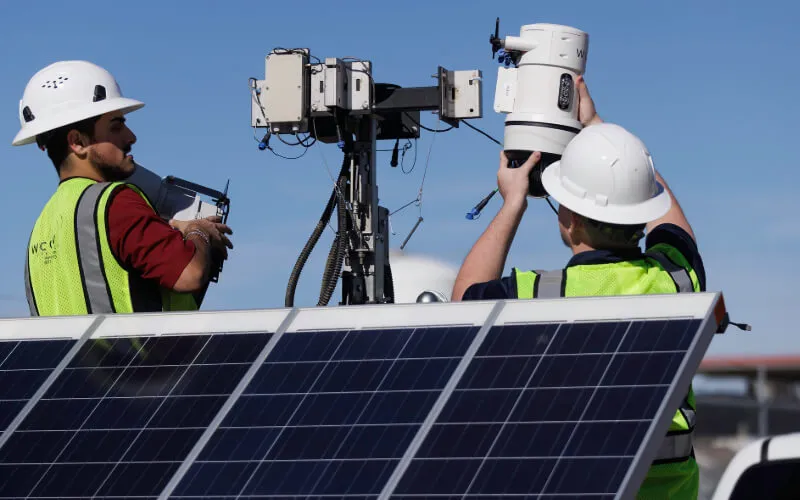
Reduced Operating Costs
Among the myriad benefits offered by solar surveillance trailers is that they are powered entirely by free, renewable energy sources.
Not only does this have a positive impact on our environment, but it also helps companies manage the costs that are usually associated with running surveillance units.
Deploying a solar-powered surveillance system removes a company's reliance on solutions such as diesel-powered generators, which helps minimize operating costs:
Fuel cost comparison:
- Traditional security cameras: Previous-generation security camera setups relied upon a continuous energy supply from grid electricity or diesel generators.
- Solar Surveillance Trailers: These solutions utilize solar panels to harness sunlight during the day, converting it into electricity which is stored within high-performance long-run batteries that power the units when no sunlight is available. This energy generation costs absolutely nothing, removing energy bills altogether.
This is yet another win-win situation for solar trailers, too, as their solar power supply also helps to improve reliability and performance, and minimizes ongoing maintenance costs.
For example, if the power grid goes down, solar surveillance will continue to operate unaffected, whereas traditional security cameras would go down with the grid - leaving your locations vulnerable.
Additionally, surveillance units powered by diesel generators require regular refueling to maintain operation, which most often requires a manual visit to the unit to perform the refueling process.
So, how do these benefits translate into cost-savings? First, let's look at the benefits of taking security cameras off your power grid:
Example Cost Saving Calculation:
- Energy Consumption: Traditional security cameras consume an average of 10 kWh of electricity a day. At an average cost of $0.13 per kWh (as of June 2024), this equates to $1.30 a day or $475 a year.
- Solar Energy: Solar surveillance trailers do not require energy consumption, so for every camera replaced by one, there is a cost-benefit of $475 per year.
While this may not immediately stand out as a significant cost saving, consider that one surveillance trailer can easily do the work of multiple fixed security cameras due to their elevated height, wide field of view, and PTZ capabilities.
The cost benefits of removing multiple security cameras across multiple sites and replacing them with solar trailers will quickly stack up.
Next, let's explore the cost benefits of replacing diesel generator-powered surveillance units with solar surveillance trailers:
Example Cost Saving Calculation:
- Fuel Costs: Diesel generators will typically consume a gallon of fuel every hour, with fuel costing around $3.50 per gallon (as of June 2024). The daily fuel consumption of a generator will depend on how many hours per day it is operational, but let's say you run the generator during non-business hours, or 6 pm to 6 am = 12 hours a day. This adds up to $42 per day, or $15,330 a year.
- Maintenance Costs: Generators contain several moving parts that require regular maintenance and upkeep. We estimate a diesel generator's annual upkeep costs at approximately $1,000.
- Total Savings: Companies that use solar surveillance trailers instead of diesel-powered alternatives can save up to $16,300 per trailer.
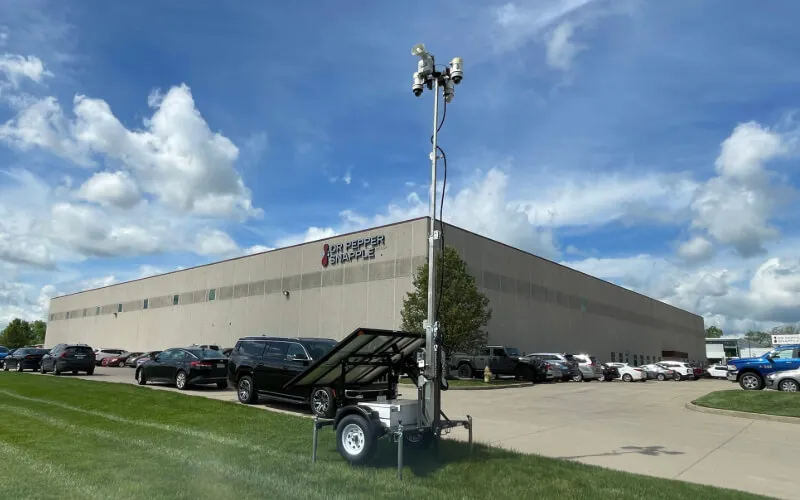
Theft and Vandalism Prevention
The primary purpose of solar surveillance trailers is to provide temporary security or deliver targeted surveillance at a particular location.
Their effectiveness as a crime prevention system can provide significant cost savings to organizations looking to bolster security, such as at construction jobsites.
Construction sites are particularly vulnerable to theft and vandalism because they often lack robust security measures and contain several high-value materials and assets.
The following statistics present the scale of the issue:
- Average Construction Losses Due to Theft: The National Equipment Register (NER) and National Insurance Crime Bureau (NICB) estimate the annual losses of construction materials and machinery to theft is between $300m-$1b.
- Average Cost Per Theft Incident: The cost of a single theft incident at a construction jobsite can range from $5,000 to $10,000, depending on the size of the site, the quantity of materials taken, and the value of those items. This cost does not factor in the downtime in productivity that can follow a theft incident, which could also run into the thousands of dollars.
- Vandalism Costs: Figures provided by the Construction Industry Crime Program (CICP) show that vandalism incidents can cost construction sites between $3,000 - $5,000 per event. This includes general vandalism of property and materials, as well as damage caused by trespass incidents.
- Frequency of Crime: Although there are no solid reports on the frequency of theft from construction sites, informal and anecdotal evidence suggests that sites can be targeted multiple times a year.
- Recovery Rates: We have previously explored how less than 25% of materials stolen from construction sites are ever recovered.
Construction sites are even more vulnerable to crimes during the summer season, as criminals tend to prefer favorable weather conditions. Crime rates are set to peak over the coming months, with August generally seen as the most likely month for construction crimes to occur.
Example Cost Saving Calculations:
Theft Reduction:
- If a construction site without security measures suffers two theft incidents per year, with each costing $7,500, the annual cost savings from theft prevention would be $15,000.
- Although we are firm believers in the effectiveness of solar surveillance trailers, anyone who claims their security system can prevent 100% of crime is far too optimistic. We can estimate that a solar surveillance trailer, backed by remote monitoring services, can prevent up to 85% of crimes.
- Savings from Theft Reduction: 85% of $15,000 = $12,750 savings per year.
Vandalism Reduction:
- If a construction site without security measures in place experiences three vandalism events per year, with each incident costing $4,000, the total annual loss due to vandalism is $12,000.
- If we make the same assumption that vandalism can be reduced by 85% following the implementation of solar surveillance trailers, then the following calculations show the cost savings:
- Savings from Vandalism Reduction: 85% of $12,000 = $10,200 saving per year.
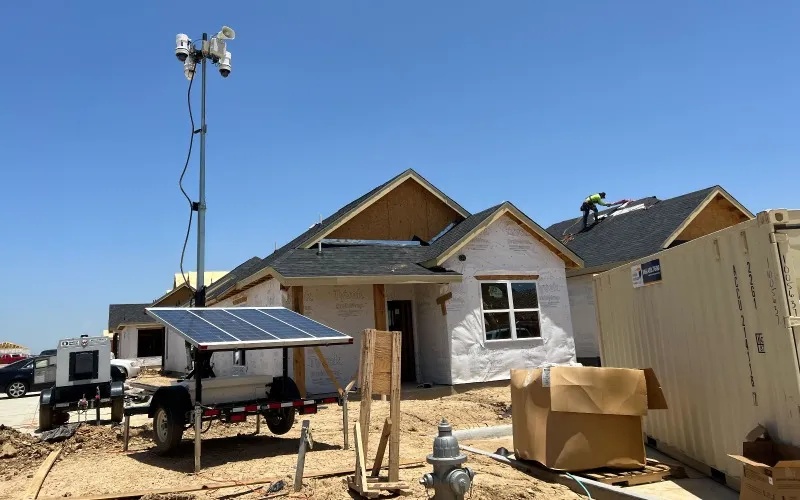
Reduced Insurance Premiums
The positive impact solar surveillance trailers have on reducing incidents of theft and vandalism at your jobsite or property may be reflected in your insurance premiums.
Many insurers will offer lower premiums to businesses that have implemented effective video surveillance solutions to boost security.
There may even be additional discounts if those video surveillance platforms are backed by a live monitoring service.
Although insurance premiums typically depend on several factors, such as location, size of the site, and value of assets kept at the premises, we can run some outline calculations to demonstrate the potential cost savings surveillance trailers offer:
Typical Construction Site Insurance Costs:
- Construction businesses typically pay between 1% and 4% of the total project cost for insurance. For a $1 million project, this would mean insurance costs between $10,000 to $40,000 annually.
- These insurance costs would cover a range of risks, with theft, vandalism, and equipment damage among them.
- Enhanced security measures, like solar surveillance trailers, can reduce the risk of theft and vandalism, leading to lower insurance premiums.
Example Cost Saving Calculation:
As mentioned above, we must preface this calculation because every insurance scenario will be different and, broadly speaking, based on a case-by-case basis.
The numbers below are for illustrative purposes only and do not guarantee that your insurer will price according to our suggestions.
A construction company paying $30,000 per year for insurance could reduce their insurance premiums by 10% to 20%, saving $3,000 to $6,000 annually.
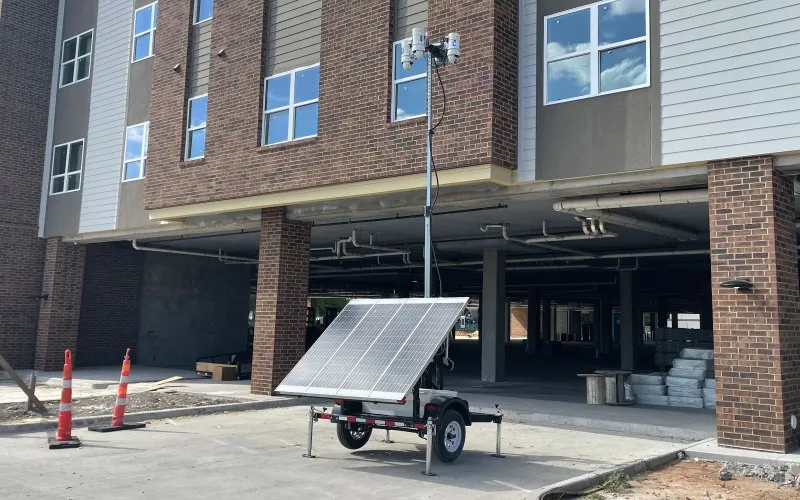
Reduced Security Guard Costs
So far, we have weighed the cost benefits of solar surveillance trailers against traditional security camera setups, but there are other security options, too.
One common alternative to surveillance units is security guards, armed or unarmed personnel who patrol a location to protect it from criminal activity.
We have previously explored the cost and reliability benefits that mobile surveillance cameras deliver compared to guarding services, but let's revisit this in the content of solar surveillance trailers vs. guards.
Typical Security Guard Costs:
- The cost of hiring a security guard can vary widely from state to state, and costs will depend on additional factors such as which company you use, whether you want armed or unarmed personnel and the quality, training, and experience of the guard.
- Estimated figures taken from various sources suggest that the cost of hiring a single guard can range from $25 to $85 per hour.
Example Cost Saving Calculation:
- If we take an example of a construction jobsite using a single guard to cover the periods the site is closed, say 6 pm - 6 am, then they could expect to pay between $300 to $1,020 per day. Add in weekends, public holidays, and other closure periods; these costs spiral quickly.
- Assuming the guard works a 12-hour period Monday through Friday and 24 hours over the weekend, the high-end costs are $9,180 a week or $40,000 a month.
- Hiring a solar surveillance trailer backed by proactive live monitoring services costs around $250 a week, or c.$1,050 a month.
- Cost Savings: Utilizing solar surveillance trailers can reduce guarding costs by up to $38,950 a month.
When discussing the cost benefits of solar trailers vs guards, it's crucial to restate the performance benefits that are also gained by using surveillance technology vs guards.
A solar surveillance trailer never calls in sick, never takes a break, never steals, deters crime, provides a live response, and video documents all events at a budget-efficient cost.
Additional Cost Benefits of Solar Surveillance Trailers
Alongside the core cost-saving benefit of solar surveillance trailers, there are additional ways in which they can help to optimize your bottom line.
Solar surveillance trailers can typically be rented in addition to being purchased outright. Hiring a surveillance trailer allows organizations to pay for security only when and where they need it most without a significant upfront investment.
Renting also guarantees that you will always be using the latest technology and will not be stuck with a surveillance unit that will eventually be superseded by the next generation of technology.
Finally, many states offer rebates to organizations switching to solar technology platforms, and integrating solar surveillance trailers into your overall security profile could make your business eligible for one of the many grant or rebate schemes currently available.
Summary
All the calculations used above are for illustrative purposes only, and the actual cost savings per organization or project will depend on multiple factors.
However, there is little doubt that the strategic deployment of solar surveillance trailers can help companies across many industries reduce overall costs.
From lower fuel bills to reduced losses due to crime events, solar surveillance trailers can play an essential role in helping you manage security costs in a budget-efficient way.
Ready to choose a more cost-effective approach to your security? Contact WCCTV today about our solar surveillance trailers. Complete the short contact form below, and we will contact you.
Are there any additional costs associated with renting a solar surveillance trailer?
If you are renting a solar surveillance trailer, the agreement should cover everything from equipment hire to maintenance, repairs, device connectivity, and any additional services such as video monitoring. Some companies may charge an additional fee for video monitoring, connectivity, and maintenance visits that occur over the weekend or during the holidays. Ensure that the company you're hiring your surveillance trailer from is burying a host of hidden fees in the small print.
How easy is it to relocate a solar surveillance trailer?
One of the key benefits of solar surveillance trailers is their portability and the ease with which they can be moved around your locations to address changing surveillance needs. This ability to reposition cameras with minimal cost or labor is yet another reason why they are one of the most cost-effective security options.
How effective are solar surveillance trailers in deterring crime?
Solar surveillance trailers are highly visible units, typically standing up to around 20ft tall with a large footprint. The presence of surveillance systems has been proven to discourage criminal activity through the fear of being caught on camera. When solar surveillance trailers are backed by additional proactive features such as live video monitoring, voice address systems, and sirens, they become an even more effective crime deterrent, essentially becoming a virtual security guard at a fraction of the cost.
